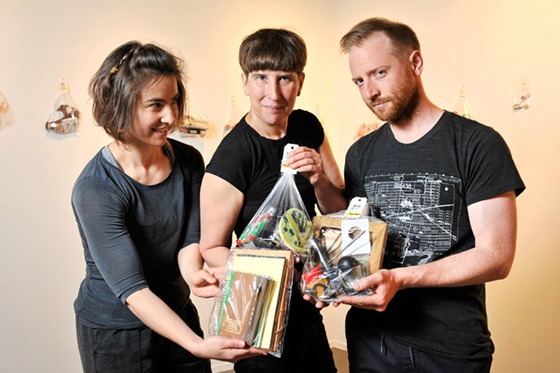For a long time, Kathryn Ricketts, assistant professor of Arts Education, has enjoyed the wall of Value Village, where clear plastic bags hang and are filled with discarded household items.
The bags usually sell for $2.99. They represent a good deal for some shoppers, but for others, they’re just a collection of useless items.
For Ricketts, it’s inspiration for an exhibition, a series of workshops and performances.
The Anthropology of the Discard is now on display at Fifth Parallel Gallery at the U of R. The public is invited to a performance May 12 at 7:30 p.m. with a closing reception to follow.
We spoke with Kathryn and asked her what she saw at Value Village that inspired her to come up with this idea.

I live close to Value Village and found myself visiting the wall of bags frequently. I was compelled by the combination of objects and how they seemed to have their own logic in connection to each other. It made me think about the person who decided which objects should be together and thought of him/her as both an Anthropologist and Curator.
I hope to ask Value Village to be an artist in residence for a period so I could work alongside that person in order to understand their choices and maybe I can make some bags as well.
Incidentally there is a wall at the exhibition where bags made by the visitors hang. Value Village has donated a box of objects and we invite anyone who visits the exhibition to be part of it by contributing their own custom made bag!
You say these bags are bulging with compelling possible new narratives. What are some of those narratives?
These are stories that are triggered by seeing the objects. They can be from our own personal memories or mere associations. We all have either in possession and or memory so many objects in our lives that are near and dear to us and have so many stories attached. I buy the bags that contain objects that seem to be attached to some of these stories.
The performance is improvisation. You are joined by local performers Johanna Bundon and Jaydon Pfeifer.
What will people see at the show?

We will start by asking the audience to choose three bags from the wall and then Jayden, Johanna and I will choose the one that seems the most potent with ‘stories waiting to be told’. We will then begin to work with one of the objects to familiarize ourselves with a story and then begin to delve into the others. All of our movement and text is entirely improvised however we are very carefully weaving our stories within an emergent history of stories that are being told by each other. As a result, characters, locations, time periods and situations begin to emerge. At times we record some of this information behind us on large banners of paper which serve as a kind of blue print of the emerging story as a whole. I harken it to standing across the street from an apartment building and watching all of the stories unfold in each of the apartments that seem to tell the story of that entire building.
What are you hoping to take away from this for your teaching?
I believe that stories have a very important place in our community and classrooms. It is through stories that we come to understand our curriculum of the world and how our education curriculum embeds itself within this. Stories are so naturally triggered from artifacts of meaning and have had a place in the classroom for a long time, i.e when we think about Show and Tell. When we work from a conglomerate of objects opposed to just one, we begin to understand how our stories interconnect with others and how this reminds us of our connected humanity.
Event: Anthropology of the Discard
Date: May 12
Time: 7:30 p.m.
Location: Fifth Parallel Gallery – Riddell Centre
A closing reception follows the performance.
By Costa Maragos Posted: May 11, 2016 U of R Feature Stories
